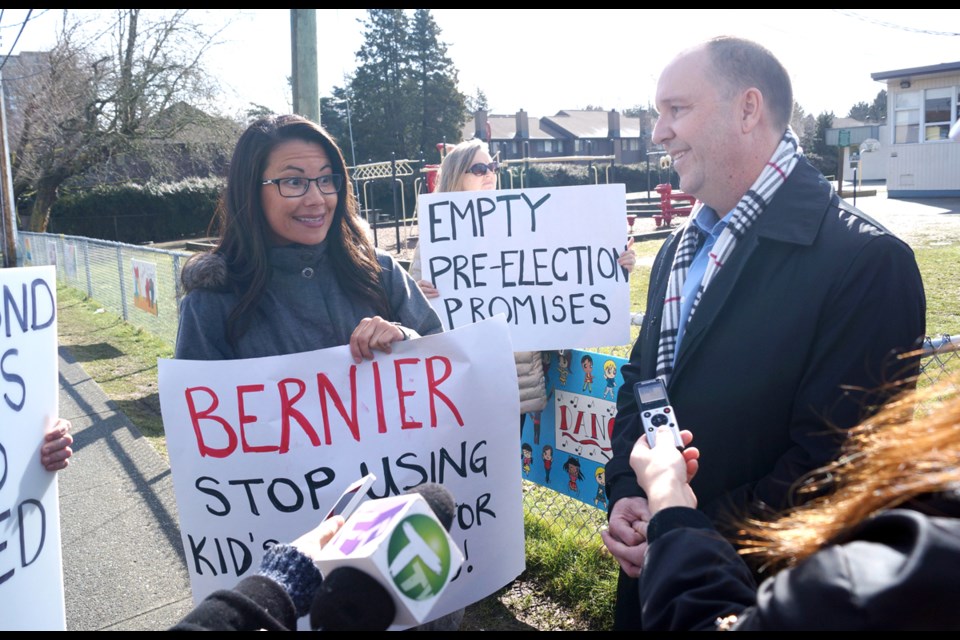Education Minister Mike Bernier made a rare appearance in Richmond to announce a $14 million upgrade to William Cook elementary school.
But it was another rare occurrence — a public face-to-face discussion between the sitting B.C. minister and one of his fiercest critics — that highlighted the apparent discord between the provincial government and Richmond parents.
Bernier began his Friday morning inside Cook’s library, in front of a handful of seemingly contented Cougars, who listened to how their school will be the first in the district, since 2011, to receive seismic upgrades, including adding four new classrooms to accommodate 95 new students.
The convivial atmosphere, however, was contained to the confines of the central Richmond school and it was only when the Minister ventured outside that he felt the full force of local parents’ discontent with the the province’s funding for the public education system.
One of the parents lying in wait for Bernier was Kim Nowitsky, of grassroots group Richmond Schools Stand United, who confronted the Minister on his ministry’s delays in upgrading local schools, including James Gilmore elementary, where the government chose to make a seismic funding announcement in the lead up to the 2013 election.
The fact that Gilmore, or any other local schools, has yet to see any of the aforementioned seismic upgrades wasn’t lost on Nowitsky when she collared Bernier, who told her that the Richmond School District has not submitted capital plans to receive seismic upgrades.
“I can’t come in and just make investments while you have a local school district that hasn’t brought things forward,” Bernier told Nowitsky.
When asked by Nowitsky what happened to Gilmore’s funding from 2013, Bernier had no answer, saying only that it preceded his time as an MLA.
School district secretary treasurer Mark de Mello told the Richmond News that Gilmore never received final funding because, although there was an announcement, the district went on to assess safety of surrounding schools and found them to be equally unsafe.
“Part of the (seismic) mitigation program was to move the students out of Gilmore and move them to neighbouring schools. It was prudent to re-test schools. All the schools tested as H1 (highest risk),” said de Mello.
“Their suggestion was to demolish Gilmore, close the school; move the kids somewhere else. If it’s taken off the list, it’s remediated,” explained de Mello.
He added that the district has submitted its capital plans to the Ministry, as opposed to what Bernier had suggested.
“Demolishing is not replacing,” Nowitsky told Bernier, who replied that, “All the different ideas need to be looked at.”
“Mmm, hmm,” replied Nowitsky.
As he continued to defend the Ministry to Nowitsky and the other parents, Bernier said that Richmond’s low student capacity (84 per cent) is still a factor in deciding on projects.
Notably, last year, Richmond’s Board of Education scrapped its school closures process (aimed at increasing capacity) in the belief that infrastructure funding was forthcoming for all Richmond schools.
“It doesn’t make any sense now for him to turn it around on the school board,” Nowitsky told the News.
“They have the paperwork done. It’s up to the Province to get the job done. (Bernier is) backtracking.”
Bernier said the government has earmarked $2 billion during the next three years for capital projects, adding that he’s committed to upgrading every school outside of Vancouver by 2025.
To date, pointed out Nowitsky, relatively little money has come to Richmond in 15 years.

Earlier in the morning, Bernier adopted a similar tone inside of Cook elementary when speaking to reporters.
“To be frank, we rely on the school districts to bring forward the project agreements for us to approve,” said Bernier.
“Until we actually have a plan from the school district, it’s hard to say where that money is going to be invested. Once we approve the projects…It is incumbent on the district to go out there and do the engineering and hire the contractors.
“I’m still waiting to know what their priorities are.”
Construction at Cook is expected to begin in the summer of 2018 and be completed by the fall of 2020, according to a Ministry statement.
“The B.C. government is protecting the quality of education for B.C. students by investing in safe and secure schools,” said Bernier, who joked that he’s often pulled aside in the Legislature by all three local BC Liberal MLAs, to make a funding announcement in Richmond.
In April, 2013, the Ministry announced $584 million “to keep high-risk schools on solid ground.”
Manoah Steves, Donald McKay, James Thompson and Quilchena elementary schools were deemed high risk then. Upon further testing, after the last election, Richmond now has 25 schools, including Cook, in need of upgrades.
Bernier said the Ministry and the district are now developing business cases for W.D Ferris, Tomsett, Steves, Quilchena and James Whiteside elementary schools.
Notably, Gilmore is said to still be in the business case stage. Considering the district is faced with a $10.5 million deficit this year, Nowitsky also criticized Bernier for forcing the district to contribute $1 million to the Cook project.



.jpg;w=120;h=80;mode=crop)